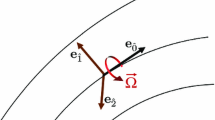Abstract
We obtain a general relativistic unification of gravitation and electromagnetism by simply(1) restricting the metric so that it admits an orthonormal tetrad representation in which the spacelike vectors are curl-free, and(2) identifying the timelike vector as the potential for an electromagnetic field whose only sources are singularities. It follows that: (A) The energy density is everywhere nonnegative, (B) the space is flat if and only if the electromagnetic field vanishes, (C) the vector potential (through which all curvature enters) admits no invariant algebraic decomposition, and satisfies the covariant Lorentz condition identically, (D) the theory is free of “prior geometry,” (E) the electromagnetic self-energy of a spherically symmetric point charge equalsMC 2, (F) particles deviate from geodesic motion according to the Lorentz force law with radiative reaction, and (G) particles with all electromagnetic multipole structures are included.
Similar content being viewed by others
References
E. Schrödinger,Space-Time Structure, (Cambridge Univ. Press, 1954), p. 99.
A. S. Eddington,The Mathematical Theory of Relativity, 2nd ed. (Cambridge University Press, 1960), p. 222.
J. L. Synge,Relativity: The General Theory (North-Holland, Amsterdam, 1960).
J. L. Synge, inPerspectives in Geometry and Relativity, B. Hoffmann, ed. (Indiana University Press, Bloomington, 1966).
G. Y. Rainich,Trans. Am. Math. Soc. 27, 106 (1925).
C. W. Misner and J. A. Wheeler,Ann. Phys. (N.Y.) 2, 525 (1957).
D. Pandres, Jr.,J. Math. Phys. 3, 602 (1962).
C. Brans and R. H. Dicke,Phys. Rev. 124, 925 (1961).
D. Pandres, Jr.,Nuovo Cim. Lett. 8, 595 (1973).
J. L. Synge and A. Schild,Tensor Calculus (Univ. of Toronto Press, Toronto, 1949), p. 297.
R. H. Dicke,Phys. Rev. 125, 2163 (1962).
W. Pauli,Theory of Relativity (Pergamon Press, New York, 1958), p. 226.
H. Weyl,Naturwiss. 38, 73 (1951); and inProceedings of the Berne Conference (1955).
C. W. Misner, K. S. Thorne, and J. A. Wheeler,Gravitation (W. H. Freeman, San Francisco, 1973), p. 429.
J. L. Anderson,Principles of Relativity Physics (Academic Press, New York, 1967), p. 83.
A. Komar,Phys. Rev. 113, 934 (1959).
L. Witten, ed.,Gravitation: An Introduction to Current Research (Wiley, New York, 1962), p. 195.
P. A. M. Dirac,Proc. Roy. Soc. (Lond.) A 167, 148 (1938).
C. Teitelboim,Phys. Rev. D 1, 1572 (1970).
Author information
Authors and Affiliations
Rights and permissions
About this article
Cite this article
Pandres, D. Gravitation and electromagnetism. Found Phys 7, 421–430 (1977). https://doi.org/10.1007/BF00711492
Received:
Issue Date:
DOI: https://doi.org/10.1007/BF00711492



